22-10-2023 - Mechanical Drawing - Roughness [EN]-[IT]
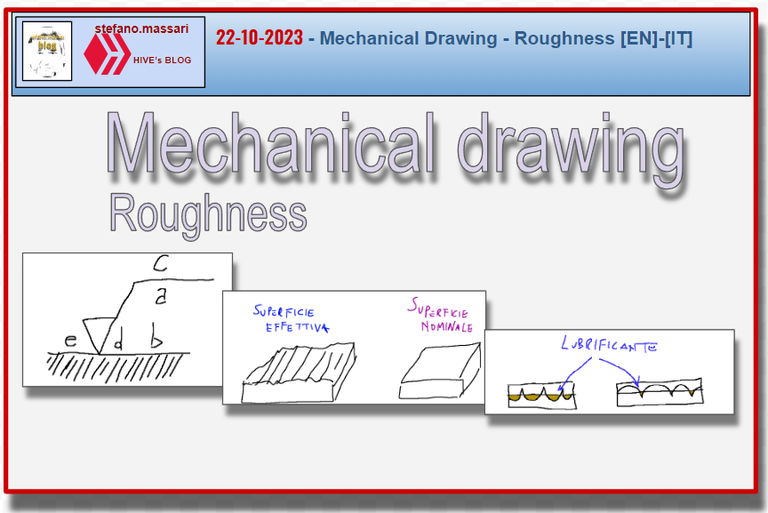
~~~ La versione in italiano inizia subito dopo la versione in inglese ~~~
ENGLISH
22-10-2023 - Mechanical Drawing - Roughness [EN]-[IT]
Roughness
Processing errors
Processing errors can be of two types: dimensional errors and geometric errors.
To ensure a good result from a construction point of view we must use manufacturing processes that ensure the required precision.
What is roughness
Roughness is a small deviation of the shape of the actual surfaces compared to the shape of the nominal surfaces.
We can repeat the concept by imagining that our nominal surface will be perfectly smooth, while in reality the actual surface will not be smooth due to the action of the tools on the surface itself.
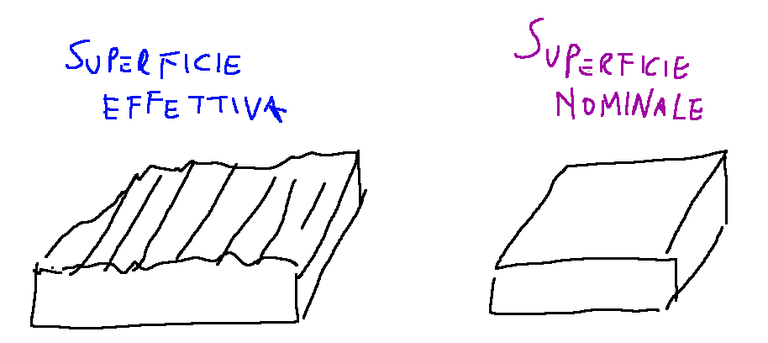
Average roughness parameter: Ra
This parameter indicates the area subtended by the roughness profile and a lower value of Ra corresponds to a smoother surface.
Or we can say that Ra is the average value of the deviations of the real profile of the surface with respect to the mean line.
This parameter is one of the most used ones and can be measured even with non-sophisticated instruments.
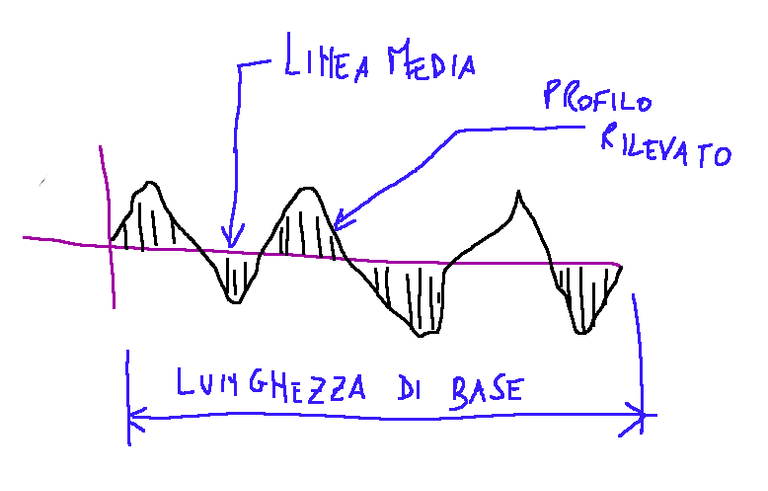
One of the disadvantages of Ra is that two surfaces can have the same Ra value, but can have different mechanical functionality. Ra is a surface finish index that is independent of the type of grooves
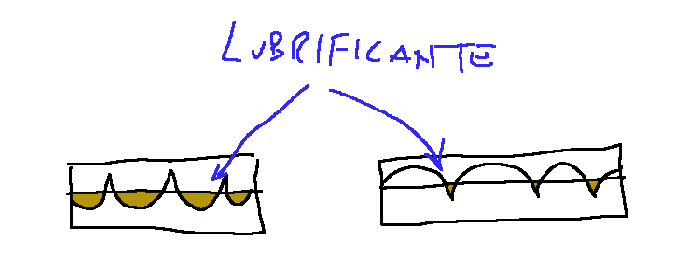
Root mean square roughness: Rq
This roughness parameter is more sensitive than Ra to peaks and valleys so it is used to control surfaces more precisely than those controlled with Ra.
Average Roughness Depth: Rz
This roughness parameter identifies the presence of accidental errors.
Maximum Roughness Depth: Rmax
This roughness parameter is used when error is not allowed.
Sign of roughness graphs
Graphic sign indicating surface processing
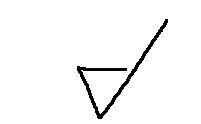
Graphic sign indicating a surface from which the removal of material is prohibited.
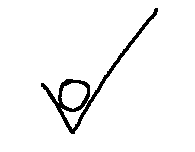
Designation of roughness parameters
Below is the complete graphic sign
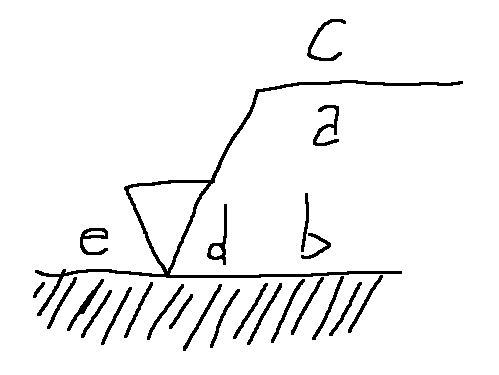
Where:
e = material to be removed (allowance)
d = orientation of sulci
c = indication of the manufacturing method, treatment or coatings
a, b = List of surface designation parameters. If the value is unique it indicates the upper limit.
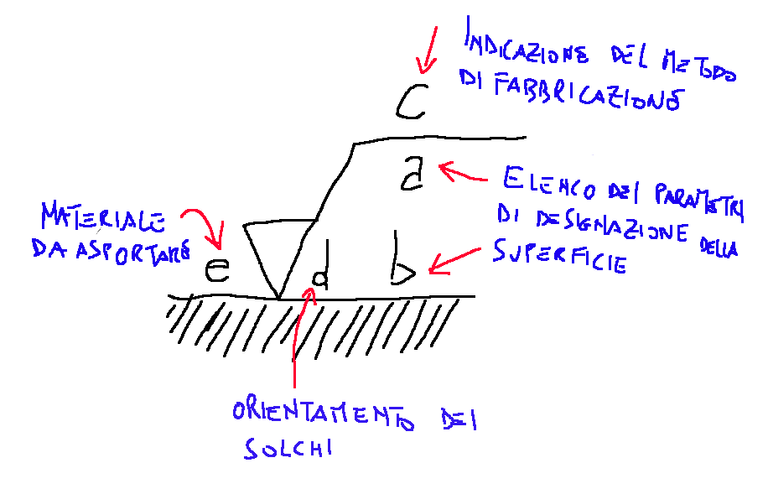
Orientation of the grooves
The orientations of the grooves can be of six types. Below we see the most used ones.
Below the indication refers to the following. The grooves must be oriented parallel to the projection plane from the view on which the graphic sign is applicable.

Below the indication refers to the following. The grooves must be oriented perpendicular to the projection plane from the view on which the graphic sign is applicable.
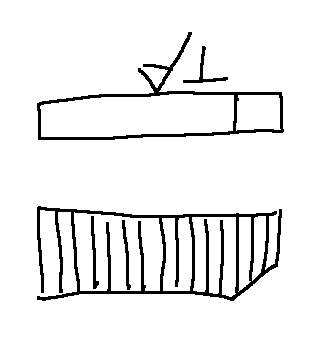
Roughness is a functional parameter because it influences the ability of a surface to maintain lubricant between two contacting surfaces.
The instrument that measures roughness is called a roughness meter
Conclusions
In technical drawing, a parameter to be indicated on the tables or surfaces of the pieces is the roughness. Roughness measures the imperfection of a surface which may not be perfect, but will have a series of shape imperfections.

ITALIAN
22-10-2023 - Mechanical Drawing - Rugosità [EN]-[IT]
Rugosità
Errori di lavorazione
Gli errori di lavorazione possono essere di due tipologie errori dimensionali ed errori geometrici.
Per assicurarci un buon risultato dal punto di vista costruttivo dobbiamo utilizzare dei procedimenti di fabbricazione che assicurino la precisione richiesta.
Cosa è la rugosità
La rugosità è un piccolo scostamento della forma delle superfici effettive rispetto alla forma delle superfici nominali.
Possiamo ripetere il concetto immaginandoci che la nostra superficie nominale sarà perfettamente liscia, mentre in realtà la superficie effettiva non lo sarà a causa dell'azione degli utensili sulla superfici stessa.

Parametro di rugosità media: Ra
Questo parametro indica l'area sottesa dal profilo di rugosità ed ad un minor valore di Ra corrisponde una superficie più liscia.
Oppure possiamo dire che Ra è il valore medio degli scostamenti del profilo reale della superficie rispetto alla linea media.
Questo parametro è uno tra quelli più usati ed è misurabile anche con strumenti non sofisticati.

Uno degli svantaggi di Ra che che due superfici possono avere lo stesso valore di Ra, ma possono avere una differente funzionalità meccanica. Ra è un indice di finitura superficiale che è indipendente dal tipo di solchi

Rugosità quadratica media: Rq
Questo parametro di rugosità è più sensibile di Ra ai picchi ed alle valli quindi viene usato per controllare superfici più precise di quelle controllate con Ra.
Profondità di Rugosità media: Rz
Questo parametro di rugosità individua la presenza di errori accidentali.
Profondità di Rugosità massima: Rmax
Questo parametro di rugosità è usato quando non è ammesso l'errore.
Segno grafici di rugosità
Segno grafico che indica lavorazione della superficie

Segno grafico che indica una superficie dalla quale è vietata l'asportazione di materiale.

Designazione di parametri di rugosità
qui di seguito il segno grafico completo

dove:
e = materiale da asportare (sovrametallo)
d = orientamento di solchi
c = indicazione del metodo di fabbricazione, trattamento o rivestimenti
a, b = Elenco dei parametri di designazione della superficie. Se il valore è unico indica il limite superiore.

Orientamento dei solchi
Gli orientamenti dei solchi possono essere di sei tipologie. Qui di seguito vediamo le più usate.
Qui di seguito l'indicazione riferisce quanto segue. I solchi devono essere orientati parallelamente al piano di proiezione dalla vista sulla quale è applicabile il segno grafico.

Qui di seguito l'indicazione riferisce quanto segue. I solchi devono essere orientati perpendicolarmente al piano di proiezione dalla vista sulla quale è applicabile il segno grafico.

La rugosità è un parametro funzionale perché influenza la capacità di una superficie di mantenere il lubrificante tra due superfici a contatto.
Lo strumento che misura la rugosità si chiama rugosimetro
Conclusioni
Nel disegno tecnico un parametro da indicare sulle tavole o sulle superfici dei pezzi è la rugosità. La rugosità misura l'imperfezione di una superficie la quale non può essere perfetta, ma avrà una serie di imperfezioni di forma.
THE END
Amazing lecture
Thank you!
Thanks for stopping by !BEER
View or trade
BEER.Hey @rafzat, here is a little bit of
BEERfrom @stefano.massari for you. Enjoy it!We love your support by voting @detlev.witness on HIVE .
Wow! Too technical for me! Do all carpenters have to know this?!
This is a beautiful question. The answer is that not all carpenters need to know these things. Those who work in specific sectors do, that is, where the technology is of a certain level
Congratulations @stefano.massari! You have completed the following achievement on the Hive blockchain And have been rewarded with New badge(s)
You can view your badges on your board and compare yourself to others in the Ranking
If you no longer want to receive notifications, reply to this comment with the word
STOP!discovery 25
Grazie per la segnalazione Liberty, provo a portare in HIVE argomenti “tecnici”. Vediamo di arricchire la piattaforma anche di queste cose. Inoltre questi post li uso anche per spiegare gli argomenti trattati ad altri. Quindi tornano utili non solo a me stesso. C’è poi da tenere presente che quando uso questi post per spiegare gli argomenti trattati, mi viene fatta sempre la seguente domanda “che piattaforma di blogging hai usato?” Avanti Tutta!
This post was shared and voted inside the discord by the curators team of discovery-it
Join our Community and follow our Curation Trail
Discovery-it is also a Witness, vote for us here
Delegate to us for passive income. Check our 80% fee-back Program
È vero che questo aiuta ad eliminare eventuali imperfezioni e persino a migliorare il disegno in base al pezzo che abbiamo ordinato di realizzare.